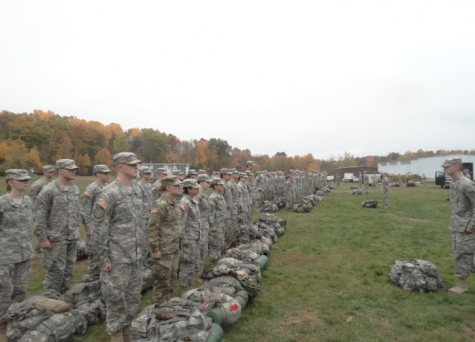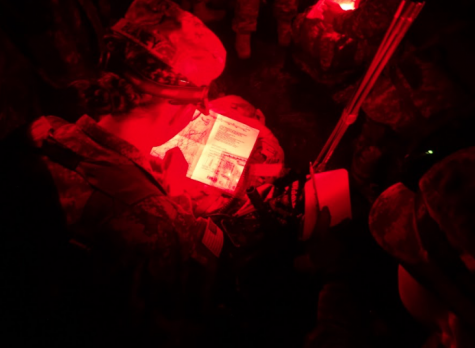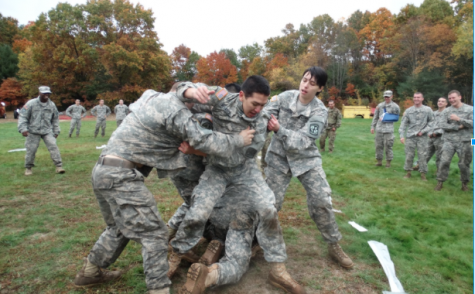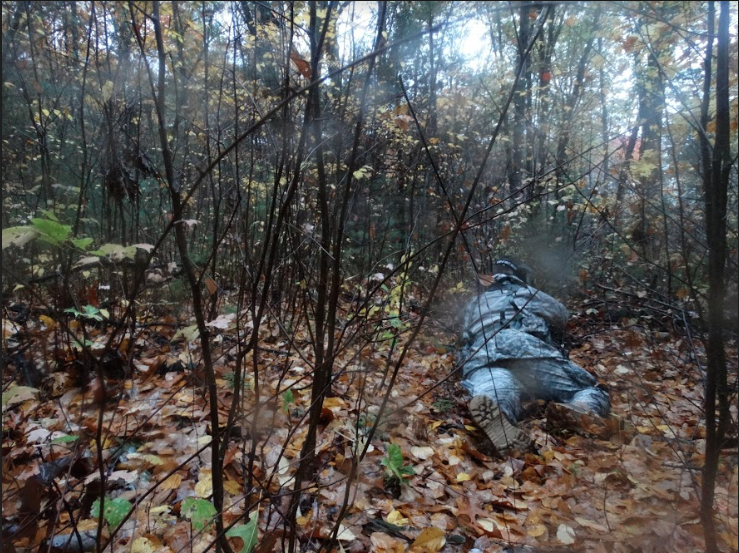A day and night with the cadets of the Minuteman Battalion
Jon Decker embedded with UMass ROTC for a field training exercise
October 31, 2016
MONTAGUE — The Friday skies were gray and heavy when I reached the Army Reserve Officer Training Corps (ROTC) building near the Southwest Residential Area. I was there to document a field training exercise conducted by the University of Massachusetts Amherst ROTC.
I didn’t quite know what to expect besides some rucking (carrying a backpack), camping and paintball matches. All I knew was the Field Training Exercise (FTX) was built to test the navigational skills, leadership and field tactics of ROTC cadets.
I walked in with the ruck the office loaned me the day before. It weighed me down, as did a camera bag dangling from my neck. An older man with arm tattoos sat at a table with two cadets. He shared a small map with them, highlighting the borders of the FTX location in Montague with a blue marker.
His name was Steven Magner, a lieutenant colonel and professor of military science at UMass Amherst.
He grinned as I approached him. He told me it was okay to take off my ruck and have a seat. Magner is one of the program’s “cadre,” or leaders. He explained cadets receive merit-based scholarships and need to maintain a strong GPA, pass rigorous physical fitness tests and go through a board review process to stay in the program. The cadets are ranked accordingly and awarded aid. A cadet can participate in the program for two years before they must sign a contract with the United States armed forces. When their four years are over, that cadet will enter the military as an officer.
This is easier said than done. On average, only twenty or so officers graduate per year from the UMass program out of the dozens that join every year. Most cadets drop out due to GPA or medical disqualification, Magner said. Falling short of the program’s academic requirements “indicates that you don’t want to work hard,” Magner said. Working hard is the primary job of a cadet.
After my talk with Magner I hopped into a red SUV headed towards the FTX location driven by cadet Brad Cassidy, a finance major. He is a “MS4,” which means he’s in his final year of ROTC.
For Cassidy, ROTC is a balancing act.
“I work ten to twenty hours a week [in addition to ROTC and class]. I have a lot of stuff on my plate,” Cassidy said.
We were joined by two more cadets, both underclassman. As we drove I asked them how they balance their schedules.
“When I was in 11th grade, something I can’t explain happened inside of me made me want to join the military,” said Yaziel Riviera, a freshman.
Instead of enlisting right out of high school, he thought it would be best to take the ROTC route and go to college.
Balancing grades, physical fitness, ROTC classes, a social life and a job can be a real challenge for cadets. Maddie Blaney, a junior sustainable food and farming major and squad leader for the day, highlighted this challenge.
“It’s a lot of organization, not slacking off and not procrastinating,” Blaney said.
Blaney says you can’t let yourself get overwhelmed, though. “If you get that feeling, it’s not good,” Blaney said.
We reached the FTX location — a patch of autumn-tinted woods behind a tractor store and junkyard — at around 5 p.m.
Corpses of trucks and tractors decorated the field adjacent to the staging area of the FTX as we all embarked from our cars. Cadets showed up in force, bringing their oversized packs to the field and dumping them in neat little lines and checking their gear. A van pulled up with more members of the cadre and supplies.

Cadets went over weapons safety protocol until Magner addressed the platoons.
“I don’t want you to be afraid of mistakes,” Magner, “Treat it like it’s real.”
As the Cadets prepared to head out into the field, they talked, joked and tried to trade provisions with each other.
“I have 20 percent of a charge for a bag of skittles,” a cadet yelled out, followed by a few laughs.
The sun set and other squads embarked into the forest. The reds and oranges of autumn were replaced with black and gray. The squad I was with donned red headlamps, taking on the appearance of alien invaders as they made their final tweaks to their rucks and paintball guns.
By 7:20 p.m., we were on the move. I hiked with them, without a headlamp, following the bobbing red lights up and down little-wet slopes. A light rain moved in. Getting to the objective, a patrol base only 900 meters away, was going to take a lot longer than normal with a group of 12 heavily loaded cadets and one semi-heavily loaded reporter.
I trudged up the hill behind a cadet named Donarumo, who not only had a fully loaded ruck, but a big, archaic looking radio sitting on his belly like a baby sling. Whenever we paused to check gear or get organized, he let off huge gasps of steam into the night air.
It was 9 p.m. by the time our group had set up the patrol base, which consisted of making a “cigar” shape of shelters.
These guys don’t get tents. Instead, they took their ponchos and stretched them into rudimentary shelters called hooches. We did not wear rain gear on the way up, so we were a bit damp.
I sat down and broke out one of the Meal Ready to Eat (MRE) packs I was issued, a brown plastic package filled with a giant energy bar, some sweets, peanut butter, crackers and a self-cooking pouch of ravioli. I wolfed it all down, only saving a bag of peanut M&Ms, and headed to a nearby hooch to ask the cadets some more questions.
I saw Donarumo, a sophomore who hopes to become a math teacher after his time in the military, and Carmine, a first-year master student with a mechanical engineering degree and hopes of getting into aviation. I kicked back a few of my peanut M&M’s from my Department of Defense Lunchable and the three of us traded jokes and stories as I took notes.

Carmine gave me the lowdown for the next day’s schedule. Wake up was at 4:30 a.m. and would take down the campsite by 5:45 a.m. He explained that the day was going to be broken in up into five phases, each with their own lanes — or exercises — and objectives.
I talked a bit with some other cadets. They talked about how soaked their boots were, except for one cadet. She grinned as she bragged about the plastic bags she wore around her socks.
I popped a sleeping gel and knocked out as the rain came down on my little tarp. At 4 a.m., I heard quiet voices and got up. I packed up, still a bit groggy from the sleeping gel. There was a heavier rain than before and the morning air was much colder. I jump into a camouflage rain suit and soon realized that I’d be hard to distinguish as a non-combatant from a distance during a paintball fight.
For breakfast, I had a squishy pouch labeled “assorted fruit.” I shrugged my shoulders and sucked out the remains of pears and peaches from the plastic, washing it down with a can of Monster Energy Drink that I saved for the morning.
We broke camp and hiked out of the patrol base deeper into the woods, following Cassidy as he navigated the morning darkness with a compass. At 6:28 a.m. we arrived at a possible starting point, also an old patrol base. There was another squad of cadets there. A few brief words were exchanged and they moved on unceremoniously.
I asked Cassidy who they were. “No idea,” he muttered.
Our radios weren’t working, so we were informed with cell phones that the lane was “hot.”
The sun had come back and the once black forest was painted with an explosion of yellows and oranges. Now it was time for me to start rolling with my GoPro and still camera as we put our paintball masks on.
Our first mission was to reach a resupply point. The squad trudged onward as the rain started to come down again. We all stayed quiet as we crept through the forest.
After about an hour or so, we found a safe point and dropped our rucks in the wet leaves. Everyone’s boots were soaked through and my rain gear had reached the point of uselessness.
But no one complained. We moved forward, leaving Riveira to guard the rucks alone in the trees.
We moved as quietly as we could, free from the burden of the bags when suddenly, the air filled with the pops of paintball guns. The squad spread out and I crouched behind a tree recording and attempting to snap pictures of the mock firefight.
I remembered Magner’s words, “treat it like it’s real,” as a couple pops went off. I heard who I thought was Cassidy barking, “Move up!”
Two cadets next to me ran up towards the mock gunshots. Not wanting to be left behind, I sprinted to the next piece of cover, keeping myself about thirty feet away from the squad’s frontline. I hit the ground and crawled into some wet leaves, making my body as flat as I could behind a tree as I snapped pictures.
I could see cadets from my group on a miniature ridge in front of me firing off rounds into the trees at someone I couldn’t see. Whenever one of them fired, a volley of paintballs returned in our direction. I wasn’t near the front line, so I probably wasn’t a target, but a few stray shots zipped near my tree and slapped some leaves a little close for comfort. I crawled as quick as I could to a better tree.
The firefight lasted for around eight minutes. By the time things got quiet, five members of the squad had been hit as “casualties.” Two were deemed to be too “incapacitated” to walk so they were carried by their companions.
We didn’t know if the people who shot at us were still out there, so we were trying to move quick. I stayed hugging trees as much as possible until we made it back to the rucks in a mock medivac (medical evacuation) situation.
After the “casualties” were treated, we believed the lane was over, but there was some confusion as to whether it was supposed to happen at all. Magner told me later this was a good thing, even if it wasn’t intended. It’s still a learning experience for his cadets. We put the wet rucks back on and hiked on through the woods.
As we descended down a hill later, one of the cadre, Sergeant First Class Simmons, 43, appeared above us and informed the group that bow hunters had been spotted in the woods. All cadets were to get out and go back to the field we started in. We headed back very quickly and within a few more hours, all the cadets were back and accounted for.
In the end, it was deemed unsafe for the cadets to be inside of the forest with hunters around. None of them were wearing orange, and no one knew the exact location of the hunters. Instead of continuing the lanes, the members of the cadre lectured the cadets about what they had seen in the field.

After instruction, the cadets played a game of “King of the Ring,” a wrestling game where competitors must push or pull each other out of a circle. There were cheers as squads faced off against each other until a winner was declared.
The reward: not having to do physical training Friday morning.
After the contest, Magner addressed his cadets, telling them to be responsible over the weekend and especially on Halloween. “Be safe, be smart, take care of each other and treat each other like family. Because that’s what you are.”
“And no clown costumes!” Simmons yelled.
Email Jon at [email protected].

